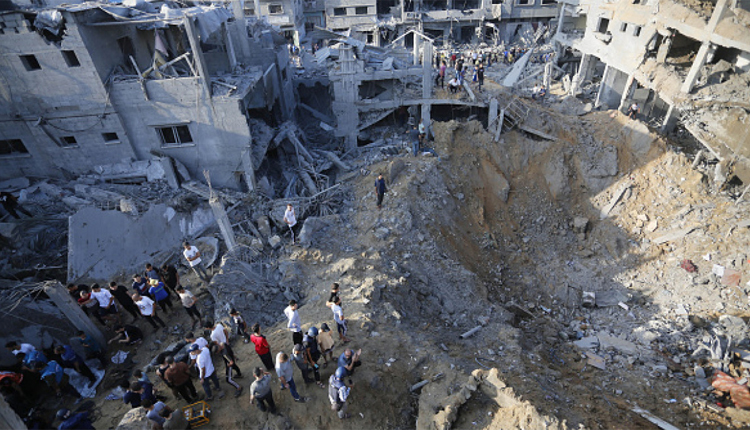Tahani al-Najjar took advantage of the calm on Saturday, after seven weeks of bombardment stopped in Gaza for a truce, to return to the ruins of her home that got destroyed by an Israeli air strike that she said killed seven of her family and forced her into a shelter.
“Where will we live? Where will we go? We are trying to collect bits of wood to build a tent to shelter us, but to no avail. There is nothing to shelter a family,” Najjar said, picking through the rubble and twisted metal of her house.
Najjar, a 58-year-old mother of five who lives in Khan Younis, said that during two earlier battles in 2008 and 2014, the Israeli military had also destroyed her home.
She pulled several miraculously intact cups from the ruins, where a bicycle and dust-caked clothes lay among the debris. “We will rebuild again,” she said.
Thousands of Gaza residents are making the same difficult ramble from communal shelters and makeshift encampments to find out what has become of their homes more than 24 hours into the four-day fighting pause.
Many of the 2.3 million residents of the Gaza Strip have benefited from the first opportunity to move around safely, assess the damage, and look for access to aid imports brought in by the almost constant cessation of air and artillery strikes.
At outdoor markets and aid depots, thousands of people stood queuing for some of the aid that began flowing into Gaza in larger quantities as part of the truce.
Since October 7th, Israel has been operating the bloodiest and most destructive attacks ever visited on the 40km-long (25 miles) Gaza enclave.
INHABITED DISTRICTS
Palestinian health officials in the Hamas-run territory say the bombardment has killed more than 14,000 people, 40 percent of them children, and flattened entire areas of residential districts. They have said thousands more bodies may stay under the rubble, still unrecorded in official death tolls.
Israel’s military last month told all civilians to leave the north of the strip, where the attacks were heaviest, but it continued to bombard the south where hundreds of thousands fled and where Najjar’s home was located.
It’s been stated that civilians can’t go back north during the truce and many of those who fled south are now seeking information from those who stayed behind.
A humanitarian crisis has been exacerbated by an accompanying blockade, which has left hospitals without enough electricity, fresh water, fuel for ambulances, food, or medication.
In a street market in Khan Younis, where variety of vegetables sat in crates, Ayman Nofal said he was able to buy more vegetables than had been available before the truce and that they cost less.
“We hope the truce will continue and be permanent, not just four or five days. People cannot pay the cost of this war,” he said.
At a U.N. agency centre in Khan Younis, people waited for cooking gas. Supplies had begun running short weeks ago and many people were cooking food over open fires fueled by scavenged wood pick up from bomb sites.
Mohammed Ghandour had been waiting five hours to fill his cylindrical metal canister, after getting up at dawn in the school where he and his family shelter and making the long trip to the depot, but was still too late. “I’m now going home without gas,” he said.


